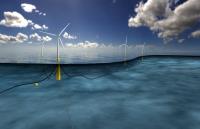 Add My Company
Add My Company
Sign In

Earlier this year a report in The Guardian announced that the world’s largest floating windfarm was set to be built off the coast of Scotland after its developers were granted a seabed lease. Statoil, the Norwegian energy company, are set to complete the pilot floating wind farm near Buchan Deep in 2017.
The floating wind farm’s position is about 25km off the coast of Peterhead in Aberdeenshire and it is expected to generate enough electricity to power 20,000 homes. There are two further pilot farms in the planning stage expected to go ahead near Kincardine and Dounreay.
The Floating Turbine
According to a recent report in The Engineer, “floating devices can tap into the vast energy resources available further offshore, where wind speeds tend to be higher and steadier.” Statoil’s floating turbine technology was first conceptualised in 2001. A scaled-down prototype was tested in 2205, and the first full-scale floating turbine was installed off of the Norwegian coast in 2009.
Based on Statoil’s background in floating oil and gas platforms, the floating slender cylinder structure was developed as the most economical and feasible concept for a floating wind turbine. In principle, it houses any offshore wind turbine, as long as the weight of the turbine is within marine stability requirements. The structure is ballast-stabilised. The cylinder is tethered to the seabed, and a pitch motion controller is integrated with the turbine’s control system, to limit excessive motions of the structure.
The problem with fixed seabed projects is that they are often limited in their positions due to quite complex seabeds. There are opportunities to locate floating wind farms where it’s impossible to have fixed turbines.
Floating wind farms also have their advantage in the realm of its manufacture. Manufacturing is easier because everything is constructed in the harbour. The fact that they are further offshore also avoids the difficulties of the visual impact of the fixed seabed projects, which are within sight of land.
North Sea Wind
In Europe, the North Sea is a relatively untapped resource in terms of its wind. Over half of the North Sea is suitable for floating devices with water depths of between 50m and 220m. Further offshore wind speeds are more palpable for wind turbines where the wind speed is higher and steadier.
Wind is an important and growing part of Europe’s industry base. Three of the five largest turbine manufacturers in the world are based in Europe. In fact Europe has over 90% of today’s offshore wind farms. Scotland is perfectly placed to become a powerhouse of renewable energy, having 25% of Europe’s total offshore wind resource.
For more information on Let the North Wind Blow: Floating Offshore Turbines talk to Applications Engineering Limited
Enquire Now
List your company on FindTheNeedle.

